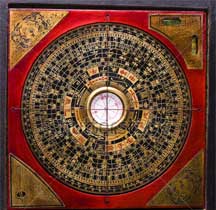The
History Of Feng Shui -
( Feng Shui History of Xingshi Pai & Liqi Pai
)
Main
Article page |
Beauty articles
|
Health page |
Computers|
Diseases |
Education |
Entertainment |
Family
Business |Fitness|
Fruits and Vegetables
|
Jobs |
General |
Personality|
Technology
|
Tourism |
Sports
House Plans |
House Loans |
Real Estate|
Vaasthu
Shastra|
Construction Tips
Engineering page
| Interior Design |
Property Buying Tips |
Renting Tips |
Journals / Magazines

Author: Feng Shui Master:
The History Of Feng Shui
: Before we can get into the history of Xingshi Pai (Form School) and Liqi Pai (Compass School) of Feng Shui I think we need to answer the question of when the use of these principles actually began. The exact origin of Feng Shui has been debated by scholars for centuries. It will depend on what criteria you want to establish as the first recognition of the principles of Feng Shui. I have seen it dated from the earliest dates of 6000 (B.C.) to as late as 1000 (B.C.).
I personally believe that the BanPo, JiangZhai and PuYang sites of Ancient China's YangShao Culture (5000-3000 B.C.) provides us with the answer. In the excavation of these sites it was found the first evidence that astrology was used in determining the placement of dwellings and graves. The PuYang grave site (Radio Carbon Test showed it was 5000 years old) revealed drawings of the Dragon and Tiger and the use of the stars for alignment.
Although it could be argued that the art of Feng Shui, originally known as Kan Yu, was practiced earlier than this, I feel this is conclusive evidence that the theories used in the Feng Shui History of Xingshi Pai & Liqi Pai Schools began as early as 5000 years ago.
In its infancy the study of this philosophy was in the land formations and environment and how they affected us. For thousands of years the shapes and placements of geological formations and their alignment with the stars were studied to help us achieve good Chi.
It wasn't until the Tang Dynasty that organized bodies of study were developed. Imperial exams even required knowledge of Feng Shui texts and their teachings (Court of Emperor Hi Tsang, 888 A.D.).
It was during the Tang Dynasty that Master Yang Yun Sang began his writings and studies of the science and formally established the Landscape School (Form School). He emphasized the identification of areas that had land formation shapes providing good Chi.
Up until this time no one had formally organized in written text the principles of Land Formation. The Ruling Class was the only group who had access to the early studies that did exist. It was through the prolific writings of Master Yang Yun Sang that the lower classes of China began to gain access to these formal studies. This is the reason that many feel Master Yun Sang should be considered the most significant figure in the history of Feng Shui.
His three most noted publications were: The History Of Feng Shui
* The Art of Rousing the Dragon (Han Lung Ching)
* Methods of Locating the Dragon's Lair (Ching Hang Ao Chih)
* Canons Approximating Dragons (I Lung Ching)
It was not until over a century later that the second traditional school evolved, the Compass School (Liqi Pai). It came into existence at about the time of the discovery of the compass (invented in China around 1044).
The Compass School of Feng Shui was initially developed primarily through the works and teachings of Master Wang Chih. The Compass School did not discredit the Form School's teaching but instead further defined them and expanded them through the use of the compass and other philosophies that evolved over time. The principles and theories that were developed in the Compass School are still practiced today.
Some of the principles and theories developed by the Compass School are:
*The Theory of Five Elements
*Octagonal BaGua utilizing compass directions and I-Ching Trigrams
*The Yin Yang Theory
*The Lo-Shu Square
*The Time Dimension
*The Kua Number
These two traditional schools remained separate until the late nineteenth century when they merged and formed the Traditional Eastern School of Feng Shui that we know today.
That concludes the Feng Shui History of Xingshi Pai & Liqi Pai. I have another article published on this site describing the Western School of Feng Shui (Black Hat Tantric Buddhism or BTB). There are many schools of thought opening up but you will find many of the basic principles and certainly the goals of each primarily the same.
Until later, please have good health, prosperity, and experience Sheng Chi! The History Of Feng Shui
Article Source: http://www.articlesbase.com/interior-design-articles/the-history-of-feng-shui-feng-shui-history-of-xingshi-pai-liqi-pai-3331032.html
About the Author: Getting bad luck recently? Not smooth in life?. Get your The History Of Feng Shui and change your luck now!.Try this Ultimate Feng Shui Solution and create Happiness, Health and Prosperity! | 


